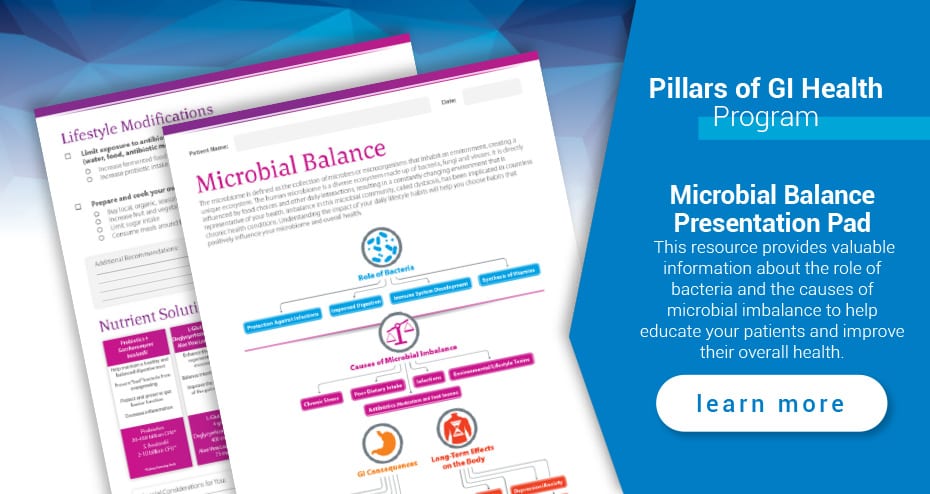The microbiome is a complex ecosystem in which a diversity of species is required for a healthy GI environment. There are over 500 different bacteria species found in our gut, the most abundant being of the Lactobacillus and Bifidobacterium genus. However, you won't find all 500 strains in any type of probiotic supplement. In fact, most probiotic supplements contain anywhere from one to 10 different strains on average and are limited to just a few genera.
Nevertheless, probiotic supplementation without a doubt has its benefits. High-quality probiotics with a diverse range of species (and a dependable and targeted delivery method) will not only populate the gut with those specific strains but also encourage the gut's other friendly bacteria populations to thrive and flourish. For example, most strains of probiotic bacteria produce acids and other substrates that alter the intestinal environment in a way that promotes the growth of natural, resident gut flora.
Possible Probiotic Pushback
Although the benefits of taking a high-quality probiotic are undeniable, it may be reasoned that you don't need any one probiotic supplement more than a couple of weeks to a couple of months at a time. It has been suggested that consuming one specific type of probiotic (even if it has five to 10 strains in the formula) may eventually “narrow” gut microbial diversity when taken over longer timeframes with some specific patients.1
Although most bacteria reproduce quickly in the gut, eventually competition, environmental impacts and individual characteristics may limit the population over longer periods of time. In fact, some research demonstrates that after longer timeframes, the benefits some people receive from taking a single probiotic supplement may gradually decrease depending on several patient factors.2
To Rotate or Not to Rotate?
Based on anecdotal evidence, some practitioners prefer to rotate probiotics with some patients while others may not. However, one thing is for certain: The needs and timing of probiotic supplementation may vary considerably based on the individual, depending on the types of foods they eat, age, activity levels, immune factors, etc.3 As a result, many practitioners feel the need to change it up every so often with some of their patients so that probiotic diversity can have the most benefit.
Taking Probiotic Diversity to the Next Level
When deciding to rotate probiotic supplementation, it is important to remember that the key is always diversity, and rotating probiotics can ensure long-term diversity for some patients. Alternating probiotics exposes the gut to new strains of probiotic bacteria and helps replenish the benefits with new bugs on a regular basis. Essentially, an individual can consume a different strain blend for a few months and then switch to a different blend of strains and so on.
The idea is that alternating or rotating different multistrain products can achieve a greater diversity because a different set of strains over time can enhance the many benefits of probiotics (fend off unwanted organisms, assist in mucosal immunity, nourish the gut lining, etc.).
Some helpful considerations when cycling probiotic supplements include the following:
- Mitochondrial DNA is especially prone to oxidative damage since it lacks histones and has a minor capacity for repair. Mitochondrial DNA mutations trigger the induction of a vicious cycle of ROS production, and excessive ROS creates many pathways for increased cardiovascular risks.
- The next probiotic in the sequence should contain a different set of strains than the first. Most preferably, the strains should feature the Lactobacillus and Bifidobacterium genus because those are the ones most commonly depleted by poor diet, toxins or other GI conditions.
- The inclusion of Saccharomyces boulardii is important at some point in the rotation. This probiotic yeast is effective at crowding out Candida, which is responsible for systemic yeast infections, and it helps stop diarrhea-type symptoms.
- Higher dosages are not necessarily needed. It is possible to stay around 20-40 billion CFU per day and still achieve diversity over time.
- Adding a prebiotic to probiotic supplementation can help feed the probiotics for their voyage through the gut and nourish the gut lining with short-chain fatty acids.
- Eating an array of fermented foods along with getting high-quality sleep can help maintain microbial balance in the gut.
The Bottom Line
Each patient’s microbiome is different and has different needs. There is no doubt that taking a multistrain probiotic has its benefits. Most strains have been demonstrated to colonize in the gut for up to a few weeks, during which time they improve the intestinal environment and encourage the recovery of our natural gut flora. However, if a patient’s response to one blend of probiotic is lackluster and does not show the benefits you hoped for, exposing them to different probiotic blends over time on a rotational basis can gradually expand diversity and help move the needle toward microbiome and overall GI health.

Joseph Ornelas, PhD, DC holds a PhD from University of Illinois with concentration in Health Economics, an MA degree in Public Policy from the Harris School at the University of Chicago, an MS degree in Health Systems Management from Rush University, and a DC degree from National University of Health Sciences. As a licensed provider and health economist, Dr. Ornelas has published numerous evidence-based clinical practice guidelines, helping to improve quality standards of care and provide value for health care practitioners across several specialty areas.
References
- Satish S, Rao C, Rehman A, Yu S, Martinez de Andino N. Brain fogginess, gas and bloating: a link between SIBO, probiotics and metabolic acidosis. Clinical and Translational Gastroenterology. 2018; 9 (6) DOI: 10.1038/s41424-018-0030-7.
- Sui J, Leighton S, Busta F, Brady L. 16S ribosomal DNA analysis of the faecal Lactobacilli composition of human subjects consuming a probiotic strain Lactobacillus acidophilus NCFM. J Appl Microbiol. 2002;93(5):907-12.
- Hill C, Guarner F, Reid G, Gibson GR, Merenstein DJ, Pot B, et al. The International Scientific Association for Probiotics and Prebiotics consensus statement on the scope and appropriate use of the term probiotic. Nat Rev Gastroenterol Hepatol. 2014;11:506-14.




